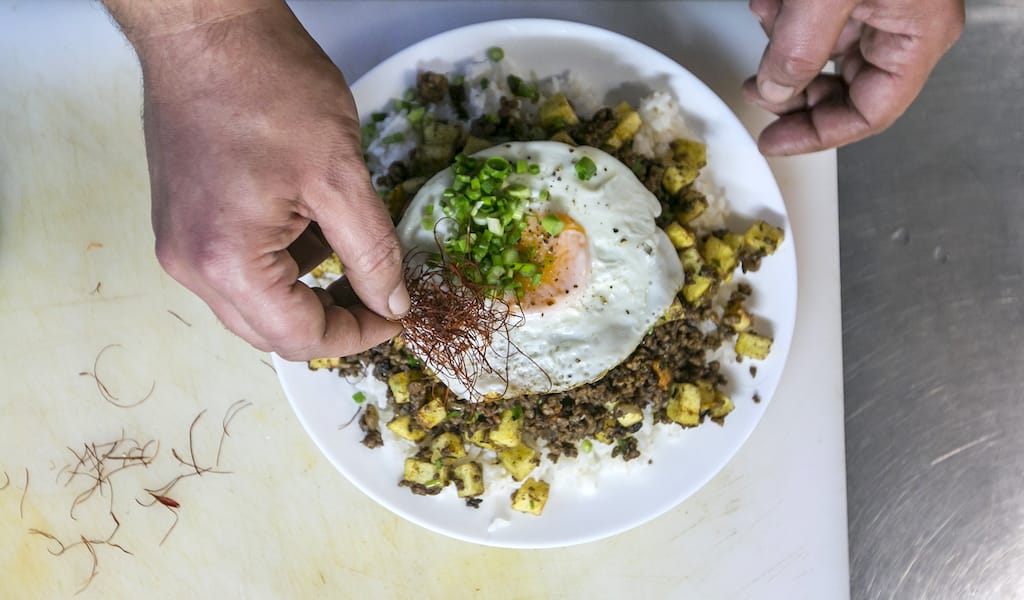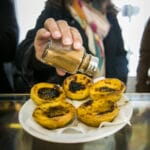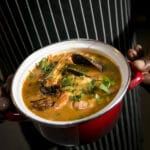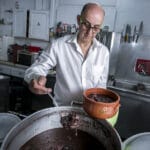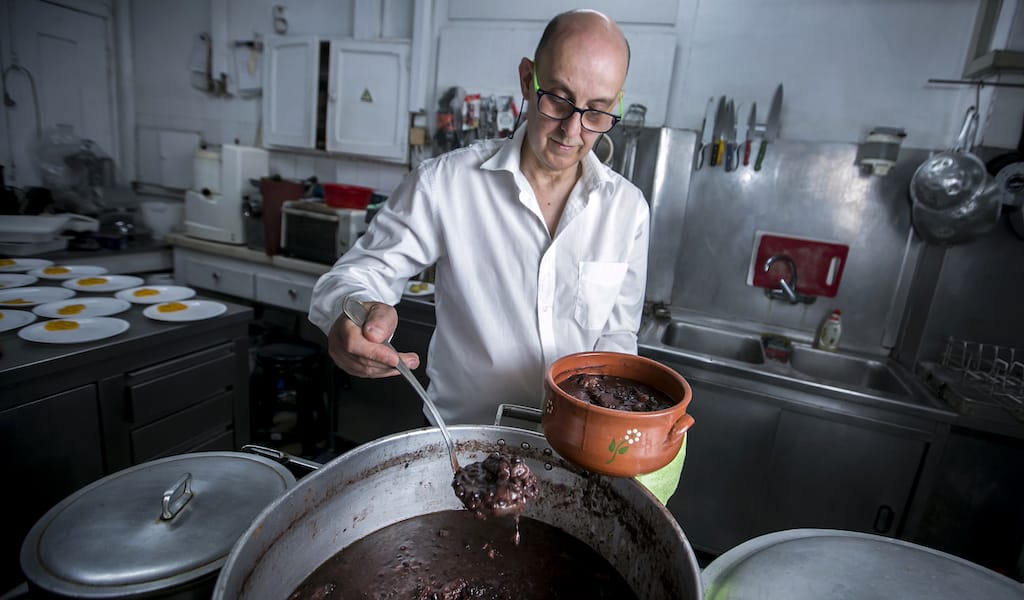On a hidden street in Lisbon’s residential Anjos neighborhood, Francisco (Chico) Jesus and Daniela Silvestre are busy prepping for dinner service. It’s still early afternoon, but there’s a lot to do before the doors of Patuá open at 7:30pm. Some Chinese art pieces are scattered about their restaurant, hinting at the tastes to come – though these only tell one part of the story. At Patuá, food hailing from the former Portuguese colony of Macau – now administered by China – anchors the menu, but the restaurant is also chronicling the evolution of the Portuguese post-colonial kitchen, with the country’s connection to India and the African continent making an appearance on the plate.
Chico and Daniela met in the kitchen of Damas, a popular restaurant-bar and club in Lisbon’s Graça neighborhood. Both had worked previously in other restaurants after studying the culinary arts, and Daniela had studied anthropology before that. “I remember that we once went shopping for food when we were still working together at Damas, and I was surprised by the depth of Chico’s knowledge of Asian ingredients and produce,” Daniela tells us. Chico’s mother is from Macau, and while he grew up in Torres Vedras (one hour north of Lisbon) his family heritage has always been a big part of his cooking.

“At home, everything was centered around the table: Does this dish need more or less soy sauce? Will my Macanese grandmother like this or that?” he says. “A gastronomic culture really exists in my family, something that is true for the Macanese community, in general. Food is a cultural statement, and the family table back in Macau had people sitting at it from different parts of the world – Guinea-Bissau, Indonesia, Angola – and, really, lots of food.”
Macanese cuisine reflects the context and history of the territory, which was leased to Portugal by China as a trading post in 1557 after the Portuguese colonized it in the early 1500s. The territory – today known for its casinos – was ruled by the Portuguese until 1999, when it was handed back to China. For almost 500 years, Lisbon and Macau kept a tie, as far apart as they are and as unlikely as this tie was to last, in the process leading to the creation of a fusion cuisine that is distinctly Macanese.
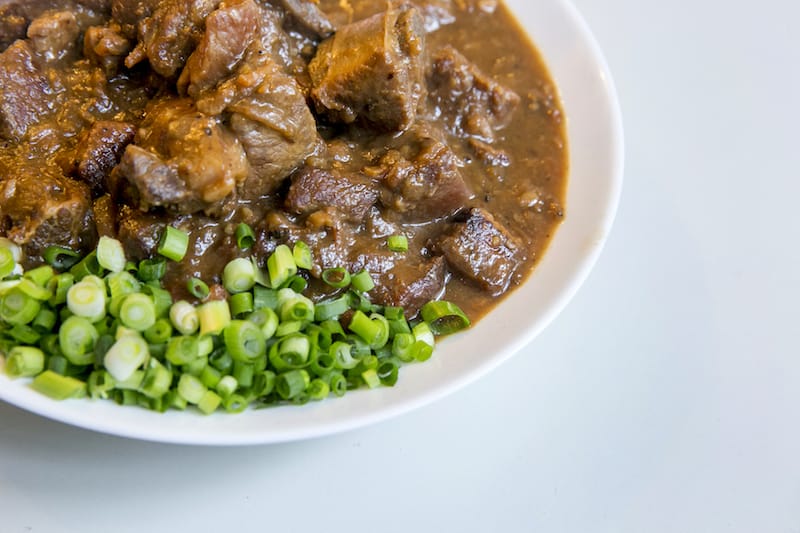
Macau was, in many ways, the epicenter of all Portuguese-related activities in Asia, with people and products from all over the continent coming and going. Since both locals and newcomers had to eat, it is easy to picture new recipes being brought to life there every day. Over 450 years later, however, those recipes are mainly still a mystery for most Portuguese people, as we’ve written before.
Even though Macau was Portugal’s last colony, Macanese eateries have been practically nonexistent in Lisbon, an obvious contrast to what happened with the other former outlying territories, from Brazil to Goa: Most are very well represented in the city’s restaurant scene. Patuá, which first opened its doors in October 2019, has been filling that gap, while also reimagining what Macanese cuisine can be.
The spark for Patuá came about when Chico, tired of making the European-influenced dishes he had always cooked professionally, started working with the Asian food and ingredients of his home, preparing it for the staff at Damas. He composed basic meals like the minchi he ate for so many years growing up, drawing the aromas and flavors from his memory. The staff loved it. Composed of rice, cubed fried potatoes and minced meat with a fried egg on top, Chico’s minchi is garnished with chives and threads of togarashi, a dried chile that tastes almost like paprika and looks like saffron. “It gives a beautiful color without the heat. And the name ‘minchi’ comes from the English minced meat,” explains Daniela.

The dish, Chico says, is a good example of the kind of cultural mixing that took place in Macau. A good example is what inspired his restaurant’s name: Patuá, Macanese patois, a mix of Portuguese, Cantonese and Malay, with dashes of other languages thrown in, from Sinhalese to Thai and English. “If we go back to the Age of Discovery, we had an even deeper mix of ethnicities and people, hence Patuá reflecting all the different languages spoken in the region, but also on the ships that traversed it. It’s like a domino set, with pieces added from the African coast, from Mozambique to India (Goa and Kerala), the Philippines, Indonesia to Macau,” Chico says.
“Macau is such a cosmopolitan and large city, always trying to please everyone, offering a bit of everything. Even the popular minchi reflects that, you could interpret it as the efforts of a Chinese woman trying to make a bitoque [a ubiquitous Portuguese dish of small steak, fries, rice, pickles and a fried egg] for her Portuguese husband.”
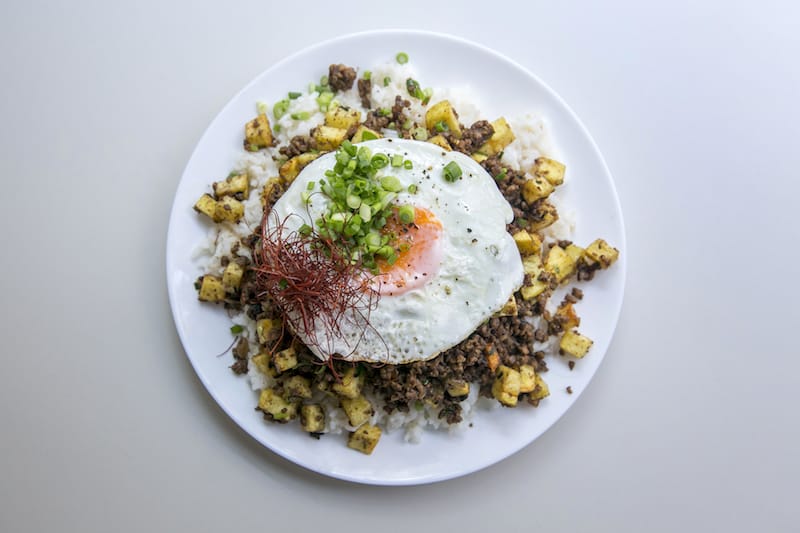
Inspired by the Patuá language’s principle of blending different influences together, Chico and Daniela started dreaming of opening up a place of their own. Finding a location was not easy, though, since in 2019 Lisbon saw soaring commercial rents. Then, after many disappointing viewings, a bar in the building where they live suddenly became available. Although the space was in poor condition, they jumped on it, doing a lot of the renovation work themselves and decorating it with old items belonging to Chico’s Macanese family.
“We say we are a restaurant with a strong influence from Macau, but I’m not trying to be a bastion of Macanese food,” Chico says. “We have influences from all over, and we want to have the freedom to present dishes from anywhere, such as caldo de mancarra [a dish from Guinea-Bissau that Chico makes with free-range chicken, peanut butter and seafood], or cabra à Tia Licínia [from São Tomé, with slow-cooked goat, palm oil, tamarind and spices].” We point out to him and Daniela that these foods all seem to be from former Portuguese colonies or the Lusophone world. “That is true, but it was not planned. It just reflects our personal taste,” Daniela adds.
A gastronomic culture really exists in my family, something that is true for the Macanese community, in general. Food is a cultural statement.
Some of the specials, which change frequently, are tributes to Chico’s Macanese family, like the prawns honoring Uncle Gégé – cooked in a Thai-Malaysian sauce with coconut milk, lemongrass and spices – or the goat dedicated to Aunt Tlicínia. These have been so popular that they might make it onto the permanent menu alongside the minchi and sambal de beringelas (Indonesian chile paste with eggplant). Though the fish dishes are seasonal, Chico promises to serve the popular peixe à cantão (deep-fried whole fish) as often as possible.

Other menu items, like a dessert called bebinca, tell the larger story of how Portugal’s expansive colonial footprint shaped how people ate. For this particular layer cake, a classic example of Indo-Portuguese cuisine in Goa but which has its roots in the tradition of convent-based sweets-making in Portugal, the pair chose a Macanese-Goan recipe they had found in a culinary compendium of Macau.
Pork with balichão (a sauce made with shrimp, pepper, bay leaf and chile) is another interesting dish that is found both in Goa (where it’s called balchão) as well as in Macau. “The Macanese version is thicker in texture and sweeter, made with tamarind,” he says.
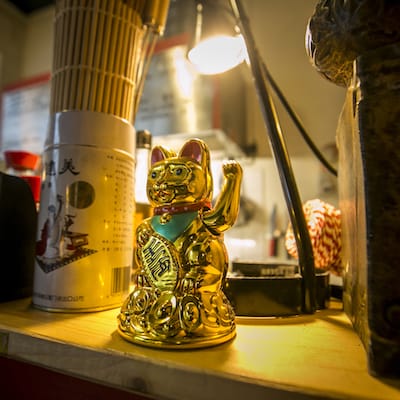 Patuá got off to a rough start, opening its doors just a few months before the pandemic hit Portugal, forcing the restaurant to temporarily shut down. Last year also had its challenges, but the restaurant seems to now be hitting its stride, drawing new fans (it was among our “Best Bites” of 2021) and earning plaudits for its cooking and thoughtful approach to the subject of Portugal’s colonial history.
Patuá got off to a rough start, opening its doors just a few months before the pandemic hit Portugal, forcing the restaurant to temporarily shut down. Last year also had its challenges, but the restaurant seems to now be hitting its stride, drawing new fans (it was among our “Best Bites” of 2021) and earning plaudits for its cooking and thoughtful approach to the subject of Portugal’s colonial history.
In its own way, Patuá appears to be part of an emerging movement to preserve Macanese culture, especially its language (UNESCO classifies Macau’s patois as “critically endangered,” estimating in 2000 that the number of active speakers was just 50). We imagine projects like Patuá could be the first of many more restaurants in Lisbon putting Macau back on the plate, as obscure as the place may seem to some locals.
Leaving Patuá after one recent delightful meal, we couldn’t help but notice that the restaurant is coincidentally located in Lisbon’s Bairro das Colónias, where all of the streets are rather superficially named for the different colonies (Patuá itself is located on Sao Tomé Street). Although in 1975 the neighborhood’s name was changed to Bairro das Novas Nações (neighborhood of the New Nations), most people still call it by the former name. There’s a wonderful irony here: In a neighborhood designed to be a monument to Portuguese colonialism, there’s a restaurant now devoted to exploring what it means to be a post-colonial kitchen and, in the process, making its mark on Lisbon.
Published on January 10, 2022
Related stories
April 4, 2024
LisbonQuick Bite: On this food tour in Lisbon, we’ll experience a cultural feast, tasting some of the most diverse bites of the city’s gastronomy and meeting the people behind them. The oldest city in Western Europe, once the hub of a trading empire that connected Macau in the east to Rio de Janeiro in the…
June 28, 2022
LisbonEditor’s Note: Though integral elements of Lisbon life, communities from Portugal’s former colonies can sometimes be an invisible presence in their adopted land, pushed out to the periphery. With our “Postcolonial Lisbon” series, CB hopes to bring these communities back into the center, looking at their cuisine, history and cultural life. In this installment, we dive…
June 27, 2022
LisbonEditor’s Note: Though integral elements of Lisbon life, communities from Portugal’s former colonies can sometimes be an invisible presence in their adopted land, pushed out to the periphery. With our "Postcolonial Lisbon” series, CB hopes to bring these communities back into the center, looking at their cuisine, history and cultural life. In this installment, we…







































